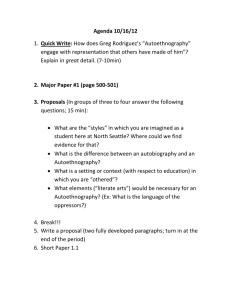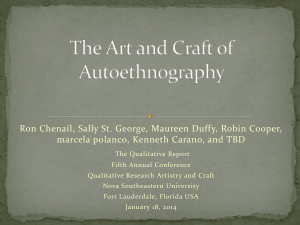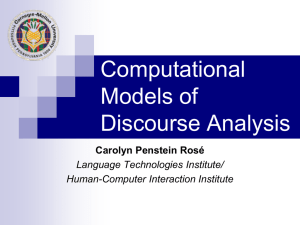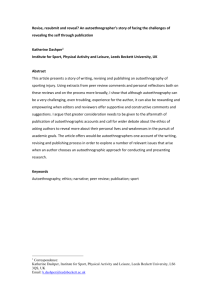Identity, Narrative & Discourse Slides
advertisement
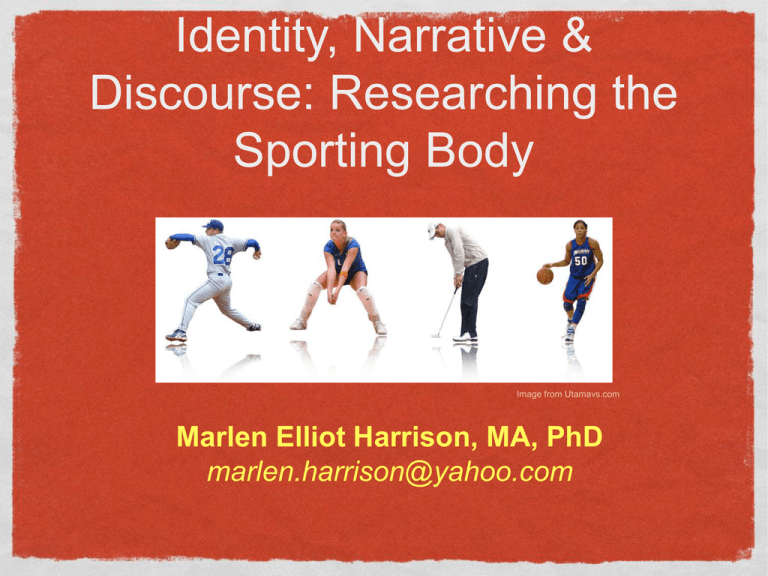
Identity, Narrative & Discourse: Researching the Sporting Body Image from Utamavs.com Marlen Elliot Harrison, MA, PhD marlen.harrison@yahoo.com Overview Abstract & Hypothesis Formation Autoethnography Story Time! Examples Definitions Limitations & Criticism Visualization About Marlen: Quant vs Qual Tension Ethical Frameworks Proposal Time! Hypothesis Formation Based on your current knowledge of the key terms identity, narrative & discourse - take a couple of minutes to develop a working hypothesis (on your own or with a partner) that explains how these three constructs may be used in applied sport psychology research. Image from Knuckleballsblog.com Abstract Identity, Narrative and Discourse: Writing & Researching the Sporting Body In considering the human body in action, language becomes the tool with which we relate our ideas, experiences and sensations and story becomes the mode of communication. Like psychological identities, so too is the human body and physical activity situated within specific discourses of knowledge, power and culture. In this discussion, I'll address how I - a former therapist, a sociolinguist and a writing professor - found a comfortable home in the discipline of sports psychology by reviewing some of the qualitative research I've guided in the fields of sport and exercise sciences while at the University of Jyvaskyla. I also share such experiences in order to highlight how the body and the athlete identity may be examined via critical, narrative approaches. More specifically, we'll consider constructivist paradigms that suggest such identities are influenced by linguistic, written, academic and cultural discourses and also explore research methods and ethical frameworks (i.e. feminist, queer, communitarian, etc) that honor the interplay of identity, narrative and discourse. Story time! Work together with a partner. Briefly tell a story about your body in relationship to physical activity or sport. When finished, your partner will share her/his story. You each have 5 minutes; keep your eye on the time! Definitions Work together in small groups: Each group will develop a definition of one of our key constructs - identity, narrative & discourse. Try to relate the concepts to the stories you told. Identity: Singular or multiple (Weinrich; Hermans)? Social or personal (Tajfel & Turner; Erikson)? Fixed or dynamic (Freud; Norton & Kano, Hall)? Disciplinary, cultural, contextual, temporal... Narrative: Often viewed as story, series of events; how does narrative reflect/construct identity (Clandinin & Connelly; Lieblich; Manfred; Pavlenko)? Theory, therapy, research, analysis... Discourse: Analyzable modes of communication (Fairclough, Gee) and meta-conversations related to struggle for authority, ownership, mastery, power (Foucault, Pennycook)... Image from Civication.org Image from Qualitative-Research.net DISCOURSE ANALYSIS Examples: Analyzing a conversation, political debate, text messages, email exchanges, Facebook posts, sports commentaries, etc. Visualization Sources: 1-Sikhnet.com; 2-Fuelyouwriting.com; 3-Rachaelhetzel.com 2 1 Narrative DISCOURSE 3 About Me - Qual vs Quant BS Psychology MA Education & Human Development: Counseling & Expressive Arts Therapies PhD Composition & TESOL: Socio- & Applied Linguistics Quant vs Qual Tension: • Science is objective, quantifiable (based in numbers), reliable, generalizable, focus on trends of large groups • Can science be subjective, non-quantifiable (based in language), variable, singular, focused on realities of individuals or small groups? Autoethnography 1 Autoethnography is an approach to research and writing that seeks to describe and systematically analyze personal experience in order to understand cultural experience. This approach challenges canonical ways of doing research and representing others and treats research as a political, socially-just and socially-conscious act. A researcher uses tenets of autobiography and ethnography to do and write autoethnography. Thus, as a method, autoethnography is both process and product. Scholars became increasingly troubled by social science's ontological, epistemological, and axiological limitations. In particular, scholars began illustrating how the "facts" and "truths" scientists "found" were inextricably tied to the vocabularies and paradigms the scientists used to represent them; they recognized the impossibility of and lack of desire for master, universal narratives; they understood new relationships between authors, audiences, and texts; and they realized that stories were complex, constitutive, meaningful phenomena that taught morals and ethics, introduced unique ways of thinking and feeling, and helped people make sense of themselves and others. Ellis, Adams & Bochner, 2010 - Autoethnography: An Overview Autoethnography II Even though some researchers still assume that research can be done from a neutral, impersonal, and objective stance, most now recognize that such an assumption is not tenable. Consequently, autoethnography is one of the approaches that acknowledges and accommodates subjectivity, emotionality, and the researcher's influence on research, rather than hiding from these matters or assuming they don't exist. Furthermore, scholars began recognizing that different kinds of people possess different assumptions about the world—a multitude of ways of speaking, writing, valuing and believing— and that conventional ways of doing and thinking about research were narrow, limiting, and parochial. These differences can stem from race, gender, sexuality, age, ability, class, education, or religion. For the most part, those who advocate and insist on canonical forms of doing and writing research are advocating a White, masculine, heterosexual, middle/upper-classed, Christian, able-bodied perspective. Autoethnography, on the other hand, expands and opens up a wider lens on the world, eschewing rigid definitions of what constitutes meaningful and useful research; this approach also helps us understand how the kinds of people we claim, or are perceived, to be influence interpretations of what we study, how we study it, and what we say about our topic. Ellis, Adams & Bochner, 2010 - Autoethnography: An Overview Ethical Frameworks Feminist Theory: Creates a problem of inequalities of power based on gender. Feminist Communitarian Ethical Framework (Denzin, Christians) questions absolute authority of researcher. Queer Theory: Creates a problem of inequalities of power based on hegemony and marginalization and questions identities as fixed(Jagose, Sullivan). Often used to examine minority identities such as queer, elderly, ethnicities, low-income, etc. Southern Theory: Creates a problem of inequalities of power and authority based on geography (Connell). The majority of scientific knowledge has been constructed by members of the Northern Hemishphere. Example Running in pain : an autoethnography of power, coercion and injury in coach-athlete relationship Hussain Haleem, 2006 This autoethnographic study investigates the emotional and social dimensions of a coaching relationship from the athlete's perspective. Autoethnography is an approach that draws on highly personalised biographical accounts in which authors tell stories about their lived experiences (Ellis Bochner, 2000; Richardson, 2000) in order to place the "self within a social context" (Reed-Danahay, 1997, p. 9). Consequently, through the analysis of my memories and ethnographic notes, I analyse my experiences as an Olympic marathon runner and, in particular, the challenges I faced with my coach. In the process of investigating the emotional and social dimensions of the coaching process (which I have divided into three phases), I focus specifically on the creation of (1) my 'athletic identity', (2) the power relationship that developed between my coach and myself and, (3) my early retirement from running. In order to make sense of my experiences, I draw upon theories of identity (e.g. Bradley, 1996), Foucauldian concepts on 'power' (e.g. Foucault, 1980), and the literature addressing 'premature retirement' (e.g. Sparkes 1996; 2000). Finally, a conclusion summarises the main points made in addition to outlining their implications for further coaching research and practice. Example I - William, the Swimmer First a swimmer (identity), but ended career after injury. North American paradigm of coaching suggested that such injury was insurmountable (discourse). Coached a swimmer in Japan and now coaches swimming in Finland (identity shift or new construction?). Befriended Estonian swimmer who suffered similar injury but found new opportunities in Finland due to different paradigms of injury and ability (queer discourse). Questioned masculinity due to injury and inability but new geographic context has him rethinking this and recognizing new identity constructions. Autoethnographic narratives with queer theoretical framework to examine how geography, injury and masculinity are related to his athlete identity and coaching philosophy. Example 2 - Kristina the Kendoka Learned the Japanese martial art of Kendo in home country of Lithuania. Kendo was not traditionally a female sport and not practiced outside Japan until recently (sport migration=queering sport). Came to Finland and met elite-level, female Kendoka and wondered what their experiences had been like, inspired by her own relationship to the sport. Hybrid feminist-queer theoretical framework and narrative methodology to capture experiences of female Kendoka and suggest that their experiences as women may have influenced their journeys as Kendoka. Researcher as member of the research community and participants as co-researchers (communitarian ethical framework). Collaborative research protocol creation. Example 3 - Naoko the Gymnast Studied gymnastics since childhood but left the sport due to growing anxiety/fear of persecution/rejection for being a lesbian (identity?). Another teammate also came out as lesbian and has encouraged her to return to the sport. Though neither is publicly open about their sexuality they want to explore other athletes’ and coaches willingness to accept such identity constructions (reflective of discourses of sexual hegemony). Using focus group discussion (method) and discourse analysis to examine attitudes by other Japanese athletes towards sexual diversity in homogeneously cultural and single-sex team sports. limitations & Criticism Talk with a partner for a few minutes and brainstorm at least two criticisms of these approaches in terms of limitations. Image from Leadwithintention.blogspot.se Create a Proposal Now that we have defined key concepts in qualitative social science research such as identity, narrative and discourse, and now that we have reviewed some examples of methods, ethical frameworks and actual projects, it’s your turn to develop a project proposal. Image from Shirtoid.com Journals • http://www.tandfonline.com/action/aboutThisJ ournal?show=aimsScope&journalCode=rqrs21 •http://www.tandfonline.com/action/aboutThisJourn al?show=aimsScope&journalCode=rijs20 •http://onlinelibrary.wiley.com/journal/10.1111/%28I SSN%2914698676/homepage/ProductInformation.html • http://www.tandfonline.com/action/aboutThisJ ournal?show=aimsScope&journalCode=cses20 •http://www.qualitative- research.net/index.php/fqs/index •http://ejournals.library.ualberta.ca/index.php/IJQM/ index • http://csc.sagepub.com/ •http://journals.humankinetics.com/about-ssj • • http://jce.sagepub.com/ • http://www.emeraldinsight.com/products/journ als/journals.htm?id=qrj http://www.tandf.co.uk/journals/rjps Thank You! Image from Totaltrust.blogspot.com • These slides are available at MarlenHarrison.com • You can contact me at marlen.harrison@yahoo.com or via my website, listed above. • Thank you to Dr. Tatiana Ryba, Noora Ronkainen and the Department of Public Health Sport Sciences at Aarhus University
